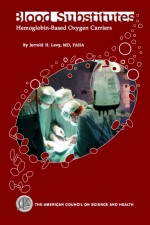
Developing a safe blood substitute has been a goal of medical researchers for decades, promoted by the traumas of both World Wars, as well as more recent wars in Asia and the Middle East. Further incentives for development of blood substitutes involved the recognition of blood borne infections, especially hepatitis B and C, and HIV. Hemoglobin based oxygen carriers (HBOCs) prepared from various sources (human, bovine, and recombinant) have been investigated; one such product is available for veterinary use (bovine derived), and another for human use in South Africa (bovine derived). While no HBOC is anticipated to replace allogeneic blood, a safe HBOC would facilitate hemodynamic stabilization until blood is available, and do so without concern for infectious agent transmission or transfusion reaction. HBOCs also have long shelf lives, a benefit when blood is in short supply or unavailable.
Human blood is a heterogeneous mixture of cells suspended in liquid plasma, which is itself a solution of functionally interacting proteins in an electrolyte buffer. The risks of allogeneic transfusion extend beyond microbial transmission to include allergy, alloimmunization, bacterial sepsis, graft versus host disease, transfusion related acute lung injury (TRALI), renal failure, volume overload, and immunosuppression.1-4 Reactions commonly associated with proinflammatory responses to transfusion are attributable to donor leukocytes that can also release inflammatory mediators, contributing to adverse outcomes. However, leukoreduction may be only partially effective in reducing the immunosuppressive effects of transfusions. Acontinuing concern with the blood supply relates to emerging bloodborne pathogens such as West Nile virus, variant CJD, and prion diseases.The need to develop a safe alternative to allogeneic blood transfusions is apparent.


